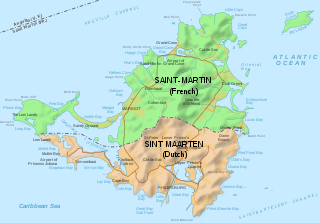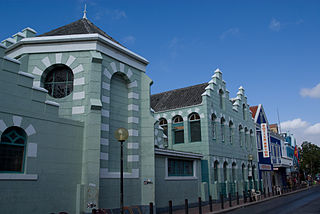Related Research Articles

The Netherlands Antilles was a constituent country of the Kingdom of the Netherlands. The country consisted of several island territories located in the Caribbean Sea. The islands were also informally known as the Dutch Antilles. The country came into being in 1954 as the autonomous successor of the Dutch colony of Curaçao and Dependencies. The Antilles were dissolved in 2010. The Dutch colony of Surinam, although relatively close by on the continent of South America, did not become part of the Netherlands Antilles but became a separate autonomous country in 1954. All the island territories that belonged to the Netherlands Antilles remain part of the kingdom today, although the legal status of each differs. As a group they are still commonly called the Dutch Caribbean, regardless of their legal status. People from this former territory continue to be called Antilleans in the Netherlands.

Saint Martin is an island in the northeast Caribbean, approximately 300 km (190 mi) east of Puerto Rico. The 87-square-kilometre (34 sq mi) island is divided roughly 60:40 between the French Republic and the Kingdom of the Netherlands, but the Dutch part is more populated than the French part. The division dates to 1648. The northern French part comprises the Collectivity of Saint Martin and is an overseas collectivity of the French Republic. The southern Dutch part comprises Sint Maarten and is one of four constituent countries that form the Kingdom of the Netherlands. Even though the island is an overseas possession of two European Union member states, only the French part of the island is part of the EU.

The SSS islands, locally also known as the Windward Islands, is a collective term for the three territories of the Dutch Caribbean that are located within the Leeward Islands group of the Lesser Antilles in the Caribbean Sea. In order of population size, they are: Sint Maarten, Sint Eustatius, and Saba. In some contexts, the term is also used to refer to the entire island of Saint Martin, alongside Sint Eustatius and Saba.
Same-sex marriages are not performed in Aruba, Curaçao, or Sint Maarten, which are constituent countries of the Kingdom of the Netherlands. The islands were obliged after several court rulings to register any marriage registered in the Kingdom, but this primarily considers residency rights, and they do not have to give same-sex marriages the same legal effect as opposite-sex marriages. Marriage in the European territory of the Netherlands, as well as in the Caribbean municipalities of Bonaire, Sint Eustatius and Saba, is open to any two people irrespective of sex.

Sint Maarten is a constituent country of the Kingdom of the Netherlands in the Caribbean region of North America. With a population of 41,486 as of January 2019 on an area of 34 km2 (13 sq mi), it encompasses the southern 44% of the divided island of Saint Martin, while the northern 56% of the island constitutes the French overseas collectivity of Saint Martin. Sint Maarten's capital is Philipsburg. Collectively, Sint Maarten and the other Dutch islands in the Caribbean are often called the Dutch Caribbean.

The Charter for the Kingdom of the Netherlands is a legal instrument that sets out the political relationship among the four countries that constitute the Kingdom of the Netherlands: Aruba, Curaçao, Sint Maarten in the Caribbean and the Netherlands in Europe. It is the leading legal document of the Kingdom. The Constitution of the Netherlands and the Basic Laws of the three other countries are legally subordinate to the Charter.

Lesbian, gay, bisexual, and transgender (LGBT) people in Aruba, which is a constituent country of the Kingdom of the Netherlands, have evolved remarkably in the past decades. Both male and female same-sex sexual activity are legal in Aruba, but same-sex marriage is not legal. Same-sex couples with Dutch nationality must travel to the Netherlands or its special municipalities to get married and the legal protection of marriage is not unconditional. Since 1 September 2021, registered partnerships have been available to both opposite-sex and same-sex couples.

The Netherlands Antilles was an autonomous Caribbean country within the Kingdom of the Netherlands. It was dissolved on 10 October 2010.

The Catholic Church in the Caribbean part of the Kingdom of the Netherlands is part of the worldwide Roman Catholic Church, under the spiritual leadership of the Pope in Rome.
The Joint Court of Justice of Aruba, Curaçao, Sint Maarten, and of Bonaire, Sint Eustatius and Saba serves the three Caribbean countries of the Kingdom of the Netherlands and the three Caribbean special municipalities of the Netherlands. The court primarily hears disputes in first instance and on appeal of these six islands, and is on the same level as similar courts in the Netherlands. Since 2012, the court has also been authorized to hear inquiry procedures originated on Curaçao, of a type that would be heard in the Netherlands by the Enterprise Chamber in Amsterdam.

The Kingdom of the Netherlands, commonly known simply as the Netherlands, is a sovereign state consisting of a collection of constituent territories united under the monarch of the Netherlands, who functions as head of state. The realm is not a federation; it is a unitary monarchy with its largest subdivision, the eponymous Netherlands, predominantly located in Northwestern Europe and with several smaller island territories located in the Caribbean.

The Caribbean Netherlands is a geographic region of the Netherlands located outside of Europe, in the Caribbean, consisting of three so-called special municipalities. These are the islands of Bonaire, Sint Eustatius and Saba, as they are also known in legislation, or the BES islands for short. The islands are officially classified as public bodies in the Netherlands and as overseas territories of the European Union; as such, European Union law does not automatically apply to them.

A common visa exists since the end of 2010 for the territories of Aruba, Curaçao, Sint Maarten and the Caribbean Netherlands which form together the territory of the Kingdom of the Netherlands in the Caribbean. The visa is not valid for the European part of the Netherlands, which is part of the Schengen Area.
The Caribbean guilder is a planned currency of Curaçao and Sint Maarten, two constituent countries of the Kingdom of the Netherlands, officially slated for introduction in 2025. The Caribbean guilder is set to replace the Netherlands Antillean guilder (ANG) at par and be pegged to the U.S. dollar. The currency has an official launch scheduled for 31 March 2025. It is divided into 100 cents.

The Dutch Caribbean are the New World territories, colonies, and countries of the Dutch Empire and the Kingdom of the Netherlands located in the Caribbean Sea, mainly the northern and southwestern regions of the Lesser Antilles archipelago.

Lesbian, gay, bisexual, and transgender (LGBT) people in Curaçao may face legal challenges not experienced by non-LGBT residents. Both male and female same-sex sexual activity are legal in Curaçao. Discrimination on the basis of "heterosexual or homosexual orientation" is outlawed by the Curaçao Criminal Code. Despite this, same-sex marriage and adoption are still not recognised.
Abortion law in Saint Kitts and Nevis, a country in the West Indies and a member of the Commonwealth of Nations, is modelled on British legislation. Abortion is permitted in circumstances where a woman's life is threatened by pregnancy.
Abortion in Guatemala is illegal, except when needed to save the woman's life. Abortion was illegal without exception prior to 1973. Congressional Decree 17-73 altered the penal code to allow abortion in cases in which the pregnant woman's life is endangered in September 1973. The procedure must be done by a physician and approved by a second doctor.
Prostitution in the Dutch Caribbean is legal and regulated. At least 500 foreign women are reportedly working in prostitution throughout the islands. Bonaire, Sint Eustatius, and Curaçao are sex tourism destinations.
Same-sex marriage has been legal in Bonaire, Sint Eustatius and Saba since 10 October 2012, the effective date of legislation passed by the States General of the Netherlands enabling same-sex couples to marry.
References
- 1 2 Pheterson, Gail; Azize, Yamila (2010). "Safe Illegal Abortion: An Inter-Island Study in the Northeast Caribbean". University of Puerto Rico. Archived from the original on 19 August 2014. Retrieved 16 August 2014.
- 1 2 Allen, Rose Mary (2010). "The Complexity of National Identity Construction in Curaçao, Dutch Caribbean" (PDF). European Review of Latin American and Caribbean Studies. 89.
- 1 2 3 Pheterson, Gail; Azize, Yamila (2008). "Abortion within and around the law in the Caribbean". Puerto Rico Health Sciences Journal. 27 (1).
- ↑ "Opinion: Abortion". Today. 28 January 2014. Archived from the original on 19 August 2014. Retrieved 16 August 2014.
